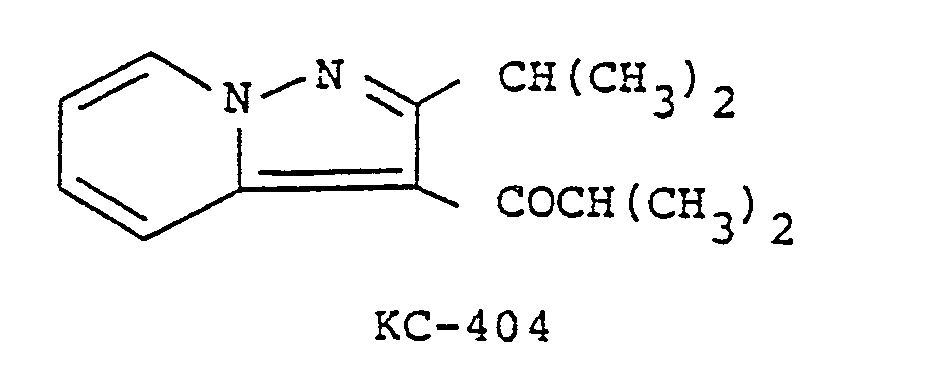[0001] 3-isobutyryl-2-isopropylpyrazalo[l,5-a]pyridine (code No. KC-404) having a chemical
structure shown below was invented by the present inventors and is a publicly known
compound as disclosed in Japanese Patent Publication No. Sho 52-293l8; U.S. Pat. 3,850,94l;
Brit. Pat. l,378,375; German Pat. 2,3l5,80l and etc. Cerebral vasodilating and bronchodilating
effects of KC-404 have been disclosed in the above patents. Our studies on KC-404
revealed that it has an inhibitory effect on the type I (immediate type) allergic
reaction (The Japanese Journal of Pharmacology
33, 267-278, l983; Folia pharmacologica japonica
83, 28l-289, l984; ibid.
83, 29l-299, l984). We found that KC-404 also inhibits the Arthus reaction (type III
allergic reaction) in a series of the experiments to determine its effects on type
II-IV allergic reactions (Folia pharmacologica japonica
83, 29l-299, l984). It is generally accepted that the drug possessing the ability to
inhibit articular rheumatism is effective in the Arthus reaction. Thus, our continuous
studies on KC-404 lead us to the present invention.

[0002] Articular rheumatism is a progressive disease with consequent economic disability,
despite intensive treatment with rest, physical therapy, gold, salicylates, and other
drugs. If the patient is severely ill and has fever, joint swelling, and intense pain,
many expert physicians advise administration of corticosteroids without delay. The
decision of embark upon a program of hormone therapy must be made with due consideration
for the fact that corticosteroid therapy, once started, may have to be continued for
many years or for life, with the attendant risks of serious complications such as
fluid and electrolyte disturbances, susceptibility to infections, peptic ulcers, osteoporosis,
a characteristic myopathy, psychosis, and Cushing's syndromes. The initial dose of
corticosteroid should be small and increased slowly until the desired degree of control
is attained. The symptomatic effect of small reductions should be frequently tested
in order to maintain the dose as low as possible. Complete relief, however, is not
sought. Thus, in the place of corticosteroid therapy or for the reduction of dose
of corticosteroids, another useful anti-rheumatic agent, surely effective and safe,
has been required.
[0003] The object of the present invention is to give a certain novel anti-rheumatic agent
containing KC-404 which is effective against articular rheumatism and causes no serious
complications.
[0004] This invention has been achieved by our discovery of the prominent effect of KC-404
on adjuvant-induced arthritis which is an experimental model of the articular rheumatism.
As shown in Experiment l, KC-404 markedly inhibits the production of adjuvant-induced
experimental arthritis in rats at the oral dose level of 20 mg/kg once or l0 mg/kg
twice every day. The results in Experiment l are indicative of the clinical effects
of KC-404. In addition, toxicological studies on KC-404 conducted in rats and mice,
namely acute toxicity tests by several routes of administration (Experiment 2), subacute
toxicity tests by oral administration for one month, and chronic toxicity tests by
oral administration for six months revealed that KC-404 is low in toxicity. These
results are supporting the safety of KC-404 for the clinical use.
[0005] The anti-rheumatic agent of the present invention may be used in the conventional
form of pharmaceutical preparations, which may be, for example, tablets, capsules,
powder, granules, injections, suppositories, ointment, cream, suitable for oral, parenteral,
enteral or local administration. The pharmaceutical formulations of the present invention
may be prepared using known technical skill in the art.
[0006] The anti-rheumatic agent of the present invention may contain KC-404 in a certain
amount. Preferable amount of KC-404 is l-500 mg per day at one time or in divided
doses and can be adjusted according to the severity of articular rheumatism and to
the age of patients.
[0007] The following examples will further illustrate the present invention without, however,
limiting it thereto.
Example l
[0008] A mixture of 4,800 g of lactose and l,200 g of Avicel® (crystalline cellulose) was
kneaded with l,800 g of 2.5 % aqueous solution of HPC-L (low molecular weight hydroxypropylcellulose).
The resulting moist mass was granulated and dried to produce a core granule having
a diameter of 0.5 - 0.7l mm. Onto the core granules thus obtained, 3,000 g of ethanol
solution containing 200 g of KC-404 and 40 g of Eudragit L® (an anionic polymer synthesized
from methacrylic acid and methacrylic acid methyl ester, soluble in intestinal juice
from pH 6 upwards) was sprayed in a fluidized bed coating apparatus (Spira-cota®)
to form a conventional granule.
Example 2
[0009] l,900 g of the granules obtained in Example l was coated with 580 g of 3.3 % ethanol
solution of Eudragit S® (an anionic polymer synthesized from methacrylic acid and
methacrylic acid methyl ester, soluble in intestinal juice from pH 7 upwards) in the
same apparatus to give a controlled-release granule.
Experiment l
[0010] Eight female Wistar rats in each group, weighing l40 - 200 g were used. The arthritis
was induced by intradermal injection of
Mycobacterium butyricum suspended in liquid paraffin (0.6 mg/0.l ml) as the adjuvant to tail. The change
in volume of both legs due to the formation of edema was measured l2, l6 and l9 days
after the adjuvant challenge. In addition, a severity of the secondary inflammation
observed in auricles, paws, legs and tail was graded into the degrees of 0 - 4. KC-404
or hydrocortisone was orally administered every day (excepting Sunday) for l9 days
including the day of the adjuvant injection. The results of experiment were given
in Tables l, 2 and 3.


Experiment 2
[0011] The results of acute toxicological experiments were shown in Table 4.

